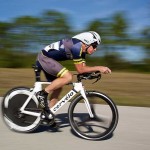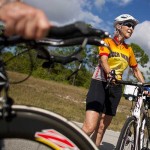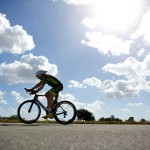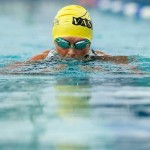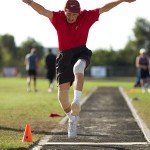THE GOLDEN YEARS BRING GOLDEN MEDALS FOR THE ATHLETES AT THE FLORIDA SENIOR GAMES
When it’s 92-year-old John C. Taylor’s turn to race at the 2013 Florida Senior Games, he has to call for backup to actually get onto his bike.
“Can you help me? Just stand against my back,” he says to a nearby volunteer.
With his weight stabilized, he lifts his leg—shaking and unsteady—an inch at a time until it’s up and over his bike. Once he’s on, however, he needs no help. The man at the starting line counts him down and he’s off—careening on two wheels just an inch wide.
Five hundred years ago, Juan Ponce de León came to Florida seeking the fabled fountain of youth (or so the story goes). He never did find it, but perhaps that’s because he wasn’t looking in the right places.
- The Athletes At The Senior Games 2013 in Florida Will Amaze You
- The Athletes At The Senior Games 2013 in Florida Will Amaze You
- The Athletes At The Senior Games 2013 in Florida Will Amaze You
- The Athletes At The Senior Games 2013 in Florida Will Amaze You
- The Athletes At The Senior Games 2013 in Florida Will Amaze You
- The Athletes At The Senior Games 2013 in Florida Will Amaze You, James Kales is 99 years old
See, the fountain of youth isn’t a mythical location with healing waters. Nor is it chalice to sip from. Instead, it’s a state of mind—and more importantly—a state of motion.
And perhaps the best place to witness the fountain of youth’s effects is at the annual Florida International Senior Games. The event, which spans 10 days and includes everything from javelin throwing to swimming and even power lifting, is a spectacle of strong bodies, strong hearts, strong minds and lots and lots of wrinkles. The Senior Games is where the 55-year-olds are the kid competitors, while 70-year-old veterans happily show them how it’s done.
“It’s daunting when they beat you, but it’s inspiring,” said cyclist John Joseph Doyle, 56, while eyeing his septuagenarian and octogenarian competition. “I hope I’m just like them in 20 years,” he added.
How do you get to be like them? The answer is surprisingly simple: get active and stay active.
“I didn’t want to go downhill mentally, so when I turned 60 I got serious about getting in shape. It’s important that you get your heart rate up at least three times a week. Your heart pumps blood to your muscles and your bones and most importantly, your brain,” says the 92-year-old menace on two wheels, Taylor.
Like Taylor, many of the athletes competing in the Senior Games 2013 Florida came to sports later in life—often as an answer to a doctor’s doomsday diagnosis.
“There was a time when I’d broken a bone every single year for several years,” says 72-year-old Jane Simpson. “My doctors said it was osteoporosis, that I’d have to go on hormones. I said, ‘I didn’t want to go on hormones.’ He said, ‘well you can try weight-bearing exercise.’ And I said, ‘will running work?’”
Today she runs between 60-80 races a year. Even more impressive: she hasn’t broken a bone since taking up the sport.
Others competing say they would have gotten an earlier start if it had been available to them. Marty Barlow-Beighley, 71, became involved with running on a whim. “At age 59 I saw a sign for a turkey trot and I thought, I should try that,” she says. Eventually, she’d meet her husband while running a 190-mile relay race. At this year’s Florida International Senior Games she was competing in a variety of track and field events.
“I’m happy I’m here now, but I see these kids here (gesturing towards local high school track and field athletes that were helping run the events) and I think, wow, I wish I could have done this then. When I was in high school this wasn’t allowed for girls.”
Simpson agrees: “When I was in high school there was nothing for women besides sewing and cooking.”
While that’s probably a hard thing for 14-year-old South Fort Myers High School student Khyana Nance—who is helping with the high jump—to understand, honestly, the whole day is a little confounding for her.
“I have to say that the whole thing is a little weird. I had no idea that older people did this stuff,” she says.
But they do. Or at least some do. More probably should. There’s no shortage of research supporting the claim that regular exercise reduces or at least slows the effects of aging. Just last year a study published in the British Journal of Sports Medicine found that those who were active after age 64 were seven times more likely to remain healthy during the aging process.
Visit the Senior Games 2013 Florida, and you’ll believe that the study’s results are valid. No one—not even 99-year-old athlete James Kales, of Bonita Springs—shows even the faintest trace of senility. No one even shows signs of slowing down.
“I still play tennis regularly with my grandchildren, and they don’t take it easy on me,” says the soon-to-be-centenarian Kales. “But my best sport, that’s ballroom dancing,” he adds.
Ballroom dancing, tennis, long jump, cycling, or tennis—it’s doesn’t really matter what you do, so long as you do it. And don’t quit. Ever.
And that may be the only thing these athletes share with poor, ill-fated de León. While these seniors have found—and cultivated—the fountain of youth, they all hope to continue doing so until they die—like de León did until he took an arrow to the thigh. “Honestly, when I die, I’d rather get hit by a truck than go to a nursing home,” says 83-year-old cyclist Don Werling. He smiles mischievously and it’s hard to know whether he’s serious or not. He’s certainly not being flippant or disrespectful to those who’ve lost lives out on the road. But it is obvious that he has no desire to go out any way but swinging.


